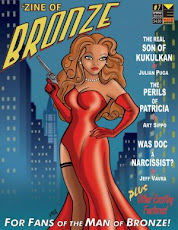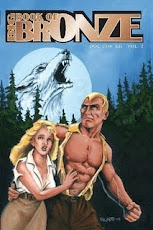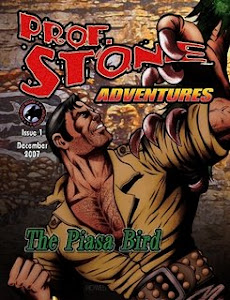
Most people who think of Doc Savage's origins will think of the work of Philip José Farmer in his books Escape from Loki, Tarzan Alive! ,and Doc Savage: His Apocalyptic Life. But if we look at the Savage Canon itself as it was written and edited by Lester Dent between 1933 and 1949, the information we find gives a different picture from the one crafted by PJF. Phil Farmer added his own creative flourish to Doc's background in some cases filling in he blanks left by Dent and in others providing what he thought were needed corrections. By doing so, He created a Doc Savage that included elements both of Dent's and his own imagination.
But what if we looked at what Dent himself included in the Canon? What conclusions might we draw? Could the data be organized in ways very different those of PJF? And might this not be closer to Lester Dent's own vision of his character?
My friend Jeff Deischer is the author of The Adventures of Doc Savage: A Definitive Chronology which is in its second edition.
Jeff firmly grounds his views using the actual material in the Canon though he does add some modest speculations of his own. What he has come up with is a unique theory about Doc's Origin and background which is different from those of the Wold Newton advocates.
I am a big fan of Phil Farmer and I really enjoy the Wold Newton Universe. I have even written some stories that lean heavily on PJF vision of Doc.
But Jeff Deischer's ideas are interesting and worthy of our perusal. He presents an alternative view of Doc Savage that has story potentials that are not possible in that Wold Newton Universe. And he has come to his views trying very hard to be faithful to Lester Dent's original work on Doc.
I was so impressed with Jeff's work that I intended to write about it here on my blog. Then I thought to myself, "Why not ask Jeff to write a brief article about this and I'll feature it here?"
So for your edification and reading pleasure, here is Jeff Deischer's article:
WHAT DENT WROTE, WHAT DENT KNEW, WHAT DENT MEANT
Copyright 2010 Jeff Deischer
Copyright 2010 Jeff Deischer
At first glance, Lester Dent, one of the co-creators and the main writer of the DOC SAVAGE series, seems to have been careless in his facts regarding Clark Savage Jr.’s background. In The Man of Bronze, the first novel of the series, Dent tells us that Doc met his five aides during the Great War – World War I. In later novels, Dent makes comments regarding Doc’s age that indicate that he was too young to have served in the war.
For example, Devil on the Moon (which occurred in 1936, according to my chronology of the series) states that Doc Savage is “a young man”. This almost certainly indicates that his life is not yet half over at the time; based on the life expectancy of a man of his era, this means that he was born no earlier than 1904. But we know that he was born by 1911, when, according to They Died Twice, he had already acquired his nickname.
Cargo Unknown states that “the elder Savage had died about the time Doc’s unusual training had been finished”, “about twenty years of training”. This strongly suggests that Doc’s birth year was about 1911, since The Man of Bronze takes place in 1931. So how could Doc have possibly served in World War I if he was born in 1911 (or even 1904)? There is some evidence that when Dent wrote The Man of Bronze, he did not have all the facts.
In The Ten Tons Snakes (written in late 1944), Dent stated that Doc “had never known just what had happened to his father to cause him to put his small son, Doc, in the hands of scientists for training”. However, in No Light to Die By (which occurred in 1946), Doc himself writes, “My father [was] victimized by criminals”, referring to the motivation of the elder Savage for Doc’s unusual training, which, Doc writes, lasted “from the time I was fourteen months old until I was twenty years old”. These comments have several significances, the most obvious of which is that it confirms that Doc was indeed about twenty in The Man of Bronze.
Second, in 1944 Dent did not know – or was prevented from saying – that Doc knew what had caused his father to have Doc trained as he was. Almost exactly two years later, Doc reveals this himself to the public. So Dent did not reveal everything there was to reveal about Doc, whether from lack of knowledge or by Doc himself preventing it. So it is possible that the same circumstance applies to Doc’s war service – or lack of it.
Third, the motivation for Clark Savage Sr. having his son trained to fight crime was because he had been victimized by criminals, not because he was trying to atone for any sins he might have committed previous to Doc’s birth. We may infer that the victimization caused the elder Savage a devastating loss, for him to go to such extremes to prevent something similar happening to others; one does not devote the life of one’s son to fighting crime because of a common mugging.
The introduction to No Light to Die By is the subject of some controversy: “Robeson” [Dent] wrote, referring to the writing of The Man of Bronze, “This thing started Nov. 12, 1932”. But Dent was relying on his memory when he wrote this, and he was wrong. In fact, the actual notation in his famous notebook reads “Dec. 10, 1932”. Philip Jose Farmer concluded that Dent was thinking of Doc’s birthday. He was not.
Information in Peril in the North conclusively puts Doc’s birthday in late May. In this story, Doc celebrates his birthday. At that time, the midnight sun is visible near Greenland. This occurs between May 25 and July 25. Due to the realities of publishing (which we know apply in Doc’s universe because of the introduction to No Light to Die By), the adventure could have occurred no later than May. The intersection of these two facts leaves only very late May for Doc’s birthday.
I believe that Dent was thinking of the date that the events that he would “novelize” as The Man of Bronze began when he wrote “Nov. 12” in No Light to Die By (he of course correctly remembered the year that he began writing). Evidence in the novel points to a placement late in the year (1931, to be exact). The date of November 12 does not disagree with any information in the novel. It in fact matches the weather and lunar data and the days of the week that seem to be weekdays and weekend days. But this is beside the point.
As I have written elsewhere, I believe the crime that befell Clark Savage Sr. was the murder of his wife. Cargo Unknown tells us that “Doc had never known his mother; she had died when he was less than a year old.” So between this time and when Doc turned fourteen months old, Clark Sr. decided to have his son trained as the Nemesis of crime. The Man Who Was Scared tells us: “Doc’s father, about the time Doc was born, evidently received some sort of shock which completely warped his outlook on life – made him devote the rest of his days to raising a son who would follow the career of righting wrongs and punishing criminals who seemed to be outside the law” (Danger Lies East calls them “the international sort”). This links the two events – the death of Doc’s mother and his father’s decision to train Doc to fight crime (chronologically, at least), leading to the not unreasonable conclusion that she was in fact murdered by criminals – and, based on the nature of Doc’s training, quite possibly by a fantastic mastermind such as those Doc himself would later face in his career. Not conclusive, I’ll grant, but very persuasive, I believe.
Dent may have known very early that Doc did not actually meet his aides in World War I. In The Land of Terror (the second novel in the series), he wrote that Doc’s “five friends … had first assembled during the Great War”. Note that it does not read “Doc and his five friends …”. Why no mention of Doc? Had Dent learned by this time that he had been in error in thinking that Doc had met his future aides during the war? Or had he been instructed by Doc to drop this fiction? In fact, the comment in The Man of Bronze is the only one in the entire series to refer to Doc being in World War I. Why? And although Dent’s notebook states that “the others were his companions in the World War”, there is not a single reference to Doc’s war service in the forty pages of notes about him – unlike that of each of the five aides. This seems a glaring omission if Doc had indeed served in the war.
What about Doc’s war medals, also described in No Light to Die By? These are four Purple Hearts. This type of medal had been discontinued before World War I and was not given out for service in that war. President Hoover reinstated it in 1932, so these awards had to have been for service during World War II. These are the only military awards of Doc’s ever mentioned in the series.
In the aforementioned Cargo Unknown, when Renny tells a friend about meeting Doc, he does not mention World War I (but he does not go into specifics). So Dent seems to have learned by 1944 that Doc had not met his future aides during the war, if he did not know earlier. Doubtless he made this aspect about Doc up because he did not know how the bronze man acquired his aides in the beginning, and it would seem awkward not to explain their relationship. By the second novel, he seems to have known that this was inaccurate, even if he did not know the true facts. If Dent ever knew the truth, he never revealed it. That Renny doesn’t reveal in Cargo Unknown how he met Doc suggests that Dent himself did not know even at this late date. But there is a clue, in – ironically -- The Man of Bronze: “Motivated by their mutual admiration for” the elder Savage, the five men “decided to take up his work of good”. If they have known Doc for more than twelve years at this point, why aren’t they motivated by him?
Doc, in The Man of Bronze, says, “Tonight we begin carrying out the ideals of my father”. Why weren’t they doing this before his death? Because Doc had not yet begun his career, and, it should be obvious by now, was too young to have done so. And the others were not yet his comrades; they seem to have been friends or colleagues of Doc’s father prior to The Man of Bronze, and knew Doc through him. This, too, is inconclusive, but very suggestive.
Because Clark Savage, Sr. was in Central America on two separate expeditions in 1911, it seems that his son would have been born “fourteen months” prior to this; certainly young Doc was in the care of scientists by this time. So Doc could have been born no later than 1910, if his father’s expeditions both occurred late in 1911.
What can we conclude? There can be no doubt that Doc Savage was born in late May, between 1904 and 1910 (inclusive). The preponderance of evidence suggests closer to 1910. I myself chose 1907, which is nothing more – and nothing less -- than a good deduction. But I could probably be talked in to either 1908 or 1909; any later than that, and I believe we have problems with Doc being a doctor by 1925, the time when he began the life-restoring process described in Resurrection Day (Doc had been working on the process for a full decade by the time of this adventure, 1935). By my reckoning, Doc became an M.D. in 1923 at the age of sixteen, after which he studied neurology.
Now that you have all the evidence, you can decide for yourself.
The truth is probably much more mundane: Dent, like later comic book writers, probably gave no real thought to the age of his hero initially, and soon found that his creation was aging much too rapidly for all the adventures he was having (Superman, for example, met President John Kennedy as both Superboy and Superman, due to this phenomenon!). So Dent simply dropped references that suggested that Doc was old enough to have served in World War I. Such is the “life” of an action hero.
But that shouldn’t stop us from enjoying the stories.
THE END

























